-
EngineDiesel Turbine PHEV
-
Power670 HP / 472 LB-FT
-
0-60 Time4.1 Seconds
-
Top Speed155 MPH
-
DrivetrainAll-Wheel Drive
-
Curb Weight3,735 LBS
-
Seating2+2
Italian Turbine-Powered Calling Card For A New Era...And A New Maserati Quattroporte?
The global meltdown that boiled to the surface in 2008 was really hard on a lot of car companies, but it was categorically horrendous for the tradition of Italian car craftsmanship out of Turin.
Of the three big players left in the traditional Italian design mecca – Italdesign Giugiaro, Bertone and Pininfarina – only Giugiaro has managed to avoid administrative takeover of its debts and assets by working out a major deal with longtime allies Volkswagen to sell them 90.1 percent of the firm. Both Bertone and Pininfarina are currently trusted to oversee their own operations but are nonetheless bonded to pay off significant operational debts to Italian banks after having hammered out merciful sweetheart low-interest deals. Neither has succeeded in closing mutually agreeable VW-style takeover bids, but both would probably prefer not doing so anyway.
The Geneva Motor Show has been treated as Italy's (and my) hometown gig ever since the once wonderful Turin auto show fizzled away in 2002. One of the great spectacles of the Swiss salon is seeing the three major houses unveil their trinkets to the press, their stands traditionally placed side-by-side for maximum effect. This year, Italdesign Giugiaro will naturally show off some Volkswagen conceptual thinking, while Bertone has once again chosen a whimsical dream showcar approach with its 1970 Stratos-inspired Nuccio concept meant to commemorate Corrozzeria Bertone's centenary.
But the Pininfarina stand will most likely steal the attention of showgoers. How can you lose with a spanking new and hot Ferrari F12 Berlinetta and a concept that seems to hint at a future replacement for the Maserati Quattroporte?
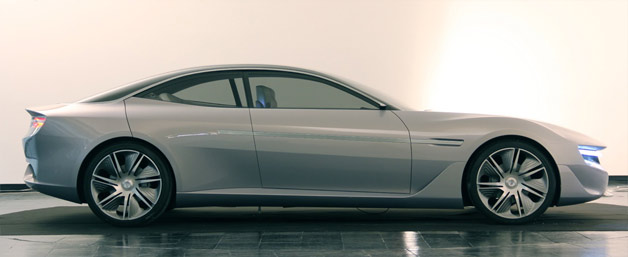
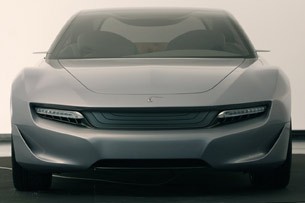
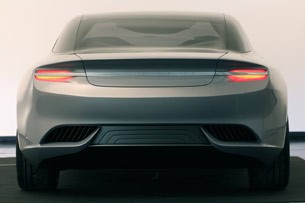
It's a bit of a regular deal for me to pay a visit or two to these friends in Turin prior to every Geneva show to get a comprehensive review of their show plans. I've honestly been more intrigued by Pininfarina's offering this year, called Cambiano, than by any of the others that will be shown. The Cambiano concept has plenty of show and spectacle, to be sure, but as it sits still and one takes it in, what comes out most is an extremely handsome, sleek execution that has lasting power. After talking with both chief creative officer Fabio Filippini (the design and styling side of the new Pininfarina) and head of product and process development Andrea Maria Benedetto (the engineering side), it's also quite clear that there is a solid business case to be made for the Cambiano.
Why call it Cambiano exactly? Two reasons: first, Cambiano (pronounced "kam-bi-AH-no") is the name of the town southeast of Turin where Pininfarina has been located since 1982, and the showcar is meant to help celebrate that 30th anniversary. From here on out, Pininfarina Stile e Ingegneria in Cambiano will be the operational and inspirational heart of the worldwide holdings of Pininfarina S.p.A., and this showcar aims to capture that feeling for the launch of the reorganized company.

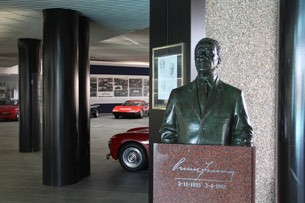
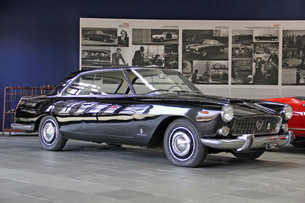
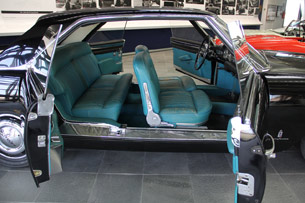
The other take on the name is that cambiano (pronounced "KAM-bya-no") translates literally from Italian as "they change." Either way, the three-door sedan-coupe is a springboard moment in Pininfarina's history as it rebuilds its roster of clients and works back to profits and reinvestment. A big part of this reorganization, however, is avoiding the trap of being a turnkey do-it-all operation that also manufactures actual cars. By 2013, all Pininfarina existing contracts to build cars will officially expire when the final Volvo C70 rolls off the line at Pininfarina Sverige in Uddevalla, Sweden.
Yes, the Cambiano has three doors. "The driver's side," says designer Filippini, "is meant to be higher tech and driving/driver focused, and a coupe best expresses these qualities." Meanwhile, the passengers' side has two doors that open in accommodating carriage style, the interior materials used are softer, and there is less onboard functionality to clutter up the living space. This door style appeared famously on founder Pinin Farina's personal car in the late 1950s, a 1957 Lancia Flaminia Florida II prototype showcar that I found and photographed in the Cambiano museum during this visit.
Before we went too much further, I shared with Filippini what was on my mind after finally having the chance to give the car a thorough in-person inspection. What I see is a bunch of potential next-generation Maserati Quattroporte and a little bit of Fisker Karma. It's always a risky moment to give the experts my less-married-to-it opinion, but this time I got no resistance; Filippini and Benedetto both are more or less in agreement with what they heard. The Cambiano, in fact, has clear Maserati design language overtones, but the attempt now is to render them a bit less pronounced – at least at the conceptual start of development.
The Karma comment comes a bit from these same lines and contours plus the long wheelbase, though, again, things are less swoopy on the Cambiano. Then there are the custom 21-inch alloys that look more like 22-inchers as on the Fisker. These huge show wheels are draped in Pininfarina-designed Fate Eximia tires from Argentina measuring 245/35 ZR21 front and 285/35 ZR21 rear.
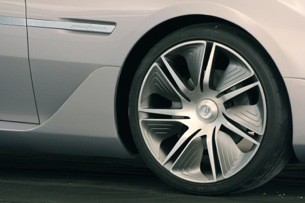
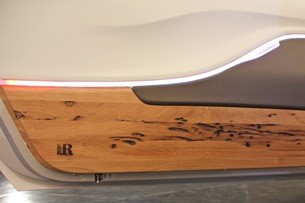
The Fisker tie-ins grew as I explored more. That distinctive wood finish on the inside lower door panels that is all over the floor and rises up between the two rear passengers to the rear shelf has been crafted using recovered oakwood poles from the canals of Venice, Italy. Every year, Venetian authorities replace at least 1,000 of these sturdy support poles that hold the city up and let boats be moored securely, the usable lifecycle of the poles being about eight years submerged in the earth and water. The design company Riva 1920 takes these recovered pieces and works its veneer magic. Fisker is likewise proud of its use of fallen timbers out of The Great Lakes.
Just like the Fisker Command Center interface and software that so impressed me, so, too, has the Cambiano's onboard functionality and usability. It works on a three-tier model with the upper right screen being the command center, establishing the driver's general preferences. The traditionally positioned instrument cluster staring at the driver through the steering wheel handles the main sat-nav indications, plus the energy level of the lithium-ion battery pack, diesel turbine activity and speedometer readout. A top tier that feels like a head-up display shows sat-nav functionality as well, can tell you the climate situation inside and outside the car, and can rate your ecological driving abilities. It's all rather flashy, which is good since the rest of the dash feels somewhat Swedish Spartan.
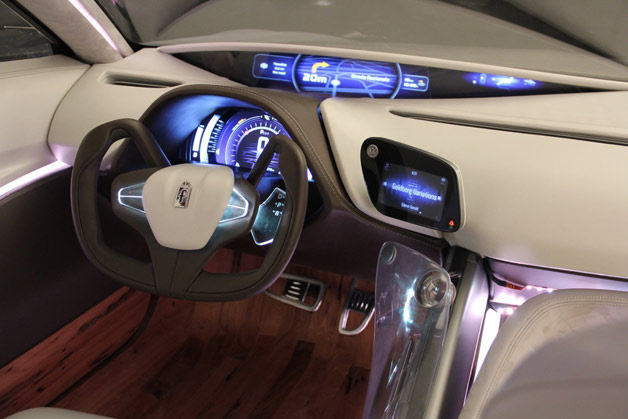
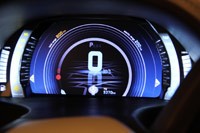
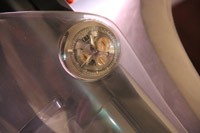
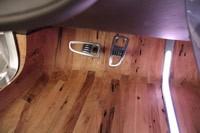
One trick detail here is on the bridge-style console next to the driver. Swiss watchmakers Bovet have modeled a custom timepiece that the owner can wear or insert in this bridge as the onboard analogue clock. The small interior dials within the time face use the same Venetian wood veneer as well and a Plexiglas piece hinges over the watch to help magnify the face and make it easily readable.
Diesel-powered turbine? Yep, I said that, too. Not since the 2010 Los Angeles Auto Show and its Jaguar C-X75 gas-turbine concept car have I been in a concept that was designed to be powered by a jet engine. The system intended for the Cambiano uses a 13.2-gallon fuel tank feeding diesel juice, if and as needed, to the single turbine mounted in front. The 40 kilowatt hour-capable turbine can distribute exactly that much energy to the 265-pound lithium-ion pack if the driver ever finds him or herself with a depleted battery, but is meant moreso to chime in every now and again to generate shots of energy for the battery under load to avoid any chance of being stranded. The lithium-ion battery cells power four 201-horsepower electric motors, one motor per wheel, in an arrangement not dissimilar to that of the first Audi R8 e-tron showcar. Actual power is listed at 670 horsepower, not 804 hp, since the battery pack can deliver just that much power to the electric motors. Quoted torque as limited by the ECU is stated at 472 pound-feet.
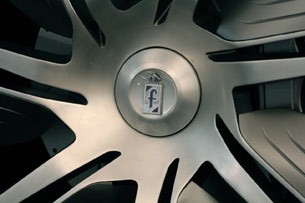
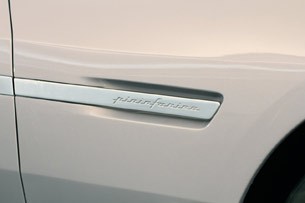
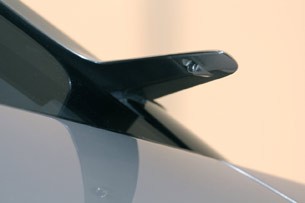
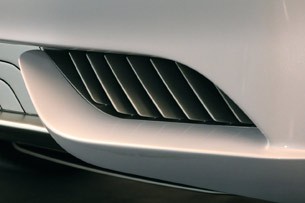
Full-EV range for this powertrain concept is estimated at about 130 miles, while complete range under ideal conditions with the 55-pound diesel turbine (from Bladon Jets in the UK) energizing the battery pack is almost 500 miles before you'll have to stop and fill up with diesel. Battery recharging can happen via the turbine, through brake energy recuperation and coasting-brake regeneration, of course, but topping up the lithium-ion units when you're home for the night or at work all day happens using a cordless inductive recharging panel underneath the car. A 40-kWh "full tank" will take you a bit over six hours of recharging.
But, back to reality now, none of this is actually in place under the skin for Cambiano's Geneva reveal. However, engineer Benedetto tells me that every integral piece of this greener pie exists and can be inserted in the intended Cambiano architecture. He showed me a complete technical plan with various supplier names to prove it. That architecture, by the way, is planned to be a carbon-fiber composite underbody and passenger cell with bolted-on fore and aft aluminum crash structures. Technically, the structure borrows a bit from the Lamborghini Aventador LP700-4 for maximum weight savings, rigidity and strength. Whereas the current Maserati Quattroporte has a curb weight of 4,389 pounds, the Cambiano would propose a next-generation Quattroporte weighing just 3,735 pounds, which bodes well for superior dynamics – dynamics enhanced further by the electric all-wheel drive with the finest form of torque vectoring possible between the four wheels.
All of this put together explains the estimated 0-60 mph acceleration of 4.1 seconds with a top speed of 155 mph. This while emitting an extremely tiny amount of CO2 on average driving cycles: just 72 grams per mile.
Pininfarina hasn't just sobered up in these austere times and sucked all the sweetness out of la dolce vita; there's even video art by Javier Fernandez that projects on the passenger cabin headliner. I was sitting quite nicely in the rear of the Cambiano when designer Filippini surprised me with the performance artist's video display – complete with a soothing wilderness soundtrack no less – digitally projected overhead. The projector sits in the rear center console and, since there is no traditional transmission per se and no center tunnel, my legs stretched out to the point where I could have been reclining in a museum of contemporary art.
So, pronounce Cambiano however you wish, but to me it honestly sounds like a smarter Pininfarina is formulating an even better Maserati sport sedan. The Turin design scene is showing real signs of recovery and advanced, intelligent thinking, and that's great news for all of us enthusiasts.
The global meltdown that boiled to the surface in 2008 was really hard on a lot of car companies, but it was categorically horrendous for the tradition of Italian car craftsmanship out of Turin.
Of the three big players left in the traditional Italian design mecca – Italdesign Giugiaro, Bertone and Pininfarina – only Giugiaro has managed to avoid administrative takeover of its debts and assets by working out a major deal with longtime allies Volkswagen to sell them 90.1 percent of the firm. Both Bertone and Pininfarina are currently trusted to oversee their own operations but are nonetheless bonded to pay off significant operational debts to Italian banks after having hammered out merciful sweetheart low-interest deals. Neither has succeeded in closing mutually agreeable VW-style takeover bids, but both would probably prefer not doing so anyway.
The Geneva Motor Show has been treated as Italy's (and my) hometown gig ever since the once wonderful Turin auto show fizzled away in 2002. One of the great spectacles of the Swiss salon is seeing the three major houses unveil their trinkets to the press, their stands traditionally placed side-by-side for maximum effect. This year, Italdesign Giugiaro will naturally show off some Volkswagen conceptual thinking, while Bertone has once again chosen a whimsical dream showcar approach with its 1970 Stratos-inspired Nuccio concept meant to commemorate Corrozzeria Bertone's centenary.
But the Pininfarina stand will most likely steal the attention of showgoers. How can you lose with a spanking new and hot Ferrari F12 Berlinetta and a concept that seems to hint at a future replacement for the Maserati Quattroporte?



It's a bit of a regular deal for me to pay a visit or two to these friends in Turin prior to every Geneva show to get a comprehensive review of their show plans. I've honestly been more intrigued by Pininfarina's offering this year, called Cambiano, than by any of the others that will be shown. The Cambiano concept has plenty of show and spectacle, to be sure, but as it sits still and one takes it in, what comes out most is an extremely handsome, sleek execution that has lasting power. After talking with both chief creative officer Fabio Filippini (the design and styling side of the new Pininfarina) and head of product and process development Andrea Maria Benedetto (the engineering side), it's also quite clear that there is a solid business case to be made for the Cambiano.
Why call it Cambiano exactly? Two reasons: first, Cambiano (pronounced "kam-bi-AH-no") is the name of the town southeast of Turin where Pininfarina has been located since 1982, and the showcar is meant to help celebrate that 30th anniversary. From here on out, Pininfarina Stile e Ingegneria in Cambiano will be the operational and inspirational heart of the worldwide holdings of Pininfarina S.p.A., and this showcar aims to capture that feeling for the launch of the reorganized company.




The other take on the name is that cambiano (pronounced "KAM-bya-no") translates literally from Italian as "they change." Either way, the three-door sedan-coupe is a springboard moment in Pininfarina's history as it rebuilds its roster of clients and works back to profits and reinvestment. A big part of this reorganization, however, is avoiding the trap of being a turnkey do-it-all operation that also manufactures actual cars. By 2013, all Pininfarina existing contracts to build cars will officially expire when the final Volvo C70 rolls off the line at Pininfarina Sverige in Uddevalla, Sweden.
Yes, the Cambiano has three doors. "The driver's side," says designer Filippini, "is meant to be higher tech and driving/driver focused, and a coupe best expresses these qualities." Meanwhile, the passengers' side has two doors that open in accommodating carriage style, the interior materials used are softer, and there is less onboard functionality to clutter up the living space. This door style appeared famously on founder Pinin Farina's personal car in the late 1950s, a 1957 Lancia Flaminia Florida II prototype showcar that I found and photographed in the Cambiano museum during this visit.
Before we went too much further, I shared with Filippini what was on my mind after finally having the chance to give the car a thorough in-person inspection. What I see is a bunch of potential next-generation Maserati Quattroporte and a little bit of Fisker Karma. It's always a risky moment to give the experts my less-married-to-it opinion, but this time I got no resistance; Filippini and Benedetto both are more or less in agreement with what they heard. The Cambiano, in fact, has clear Maserati design language overtones, but the attempt now is to render them a bit less pronounced – at least at the conceptual start of development.
The Karma comment comes a bit from these same lines and contours plus the long wheelbase, though, again, things are less swoopy on the Cambiano. Then there are the custom 21-inch alloys that look more like 22-inchers as on the Fisker. These huge show wheels are draped in Pininfarina-designed Fate Eximia tires from Argentina measuring 245/35 ZR21 front and 285/35 ZR21 rear.


The Fisker tie-ins grew as I explored more. That distinctive wood finish on the inside lower door panels that is all over the floor and rises up between the two rear passengers to the rear shelf has been crafted using recovered oakwood poles from the canals of Venice, Italy. Every year, Venetian authorities replace at least 1,000 of these sturdy support poles that hold the city up and let boats be moored securely, the usable lifecycle of the poles being about eight years submerged in the earth and water. The design company Riva 1920 takes these recovered pieces and works its veneer magic. Fisker is likewise proud of its use of fallen timbers out of The Great Lakes.
Just like the Fisker Command Center interface and software that so impressed me, so, too, has the Cambiano's onboard functionality and usability. It works on a three-tier model with the upper right screen being the command center, establishing the driver's general preferences. The traditionally positioned instrument cluster staring at the driver through the steering wheel handles the main sat-nav indications, plus the energy level of the lithium-ion battery pack, diesel turbine activity and speedometer readout. A top tier that feels like a head-up display shows sat-nav functionality as well, can tell you the climate situation inside and outside the car, and can rate your ecological driving abilities. It's all rather flashy, which is good since the rest of the dash feels somewhat Swedish Spartan.




One trick detail here is on the bridge-style console next to the driver. Swiss watchmakers Bovet have modeled a custom timepiece that the owner can wear or insert in this bridge as the onboard analogue clock. The small interior dials within the time face use the same Venetian wood veneer as well and a Plexiglas piece hinges over the watch to help magnify the face and make it easily readable.
Diesel-powered turbine? Yep, I said that, too. Not since the 2010 Los Angeles Auto Show and its Jaguar C-X75 gas-turbine concept car have I been in a concept that was designed to be powered by a jet engine. The system intended for the Cambiano uses a 13.2-gallon fuel tank feeding diesel juice, if and as needed, to the single turbine mounted in front. The 40 kilowatt hour-capable turbine can distribute exactly that much energy to the 265-pound lithium-ion pack if the driver ever finds him or herself with a depleted battery, but is meant moreso to chime in every now and again to generate shots of energy for the battery under load to avoid any chance of being stranded. The lithium-ion battery cells power four 201-horsepower electric motors, one motor per wheel, in an arrangement not dissimilar to that of the first Audi R8 e-tron showcar. Actual power is listed at 670 horsepower, not 804 hp, since the battery pack can deliver just that much power to the electric motors. Quoted torque as limited by the ECU is stated at 472 pound-feet.




Full-EV range for this powertrain concept is estimated at about 130 miles, while complete range under ideal conditions with the 55-pound diesel turbine (from Bladon Jets in the UK) energizing the battery pack is almost 500 miles before you'll have to stop and fill up with diesel. Battery recharging can happen via the turbine, through brake energy recuperation and coasting-brake regeneration, of course, but topping up the lithium-ion units when you're home for the night or at work all day happens using a cordless inductive recharging panel underneath the car. A 40-kWh "full tank" will take you a bit over six hours of recharging.
But, back to reality now, none of this is actually in place under the skin for Cambiano's Geneva reveal. However, engineer Benedetto tells me that every integral piece of this greener pie exists and can be inserted in the intended Cambiano architecture. He showed me a complete technical plan with various supplier names to prove it. That architecture, by the way, is planned to be a carbon-fiber composite underbody and passenger cell with bolted-on fore and aft aluminum crash structures. Technically, the structure borrows a bit from the Lamborghini Aventador LP700-4 for maximum weight savings, rigidity and strength. Whereas the current Maserati Quattroporte has a curb weight of 4,389 pounds, the Cambiano would propose a next-generation Quattroporte weighing just 3,735 pounds, which bodes well for superior dynamics – dynamics enhanced further by the electric all-wheel drive with the finest form of torque vectoring possible between the four wheels.
All of this put together explains the estimated 0-60 mph acceleration of 4.1 seconds with a top speed of 155 mph. This while emitting an extremely tiny amount of CO2 on average driving cycles: just 72 grams per mile.
The video meant to be presented here is no longer available. Sorry for the inconvenience.
Pininfarina hasn't just sobered up in these austere times and sucked all the sweetness out of la dolce vita; there's even video art by Javier Fernandez that projects on the passenger cabin headliner. I was sitting quite nicely in the rear of the Cambiano when designer Filippini surprised me with the performance artist's video display – complete with a soothing wilderness soundtrack no less – digitally projected overhead. The projector sits in the rear center console and, since there is no traditional transmission per se and no center tunnel, my legs stretched out to the point where I could have been reclining in a museum of contemporary art.
So, pronounce Cambiano however you wish, but to me it honestly sounds like a smarter Pininfarina is formulating an even better Maserati sport sedan. The Turin design scene is showing real signs of recovery and advanced, intelligent thinking, and that's great news for all of us enthusiasts.
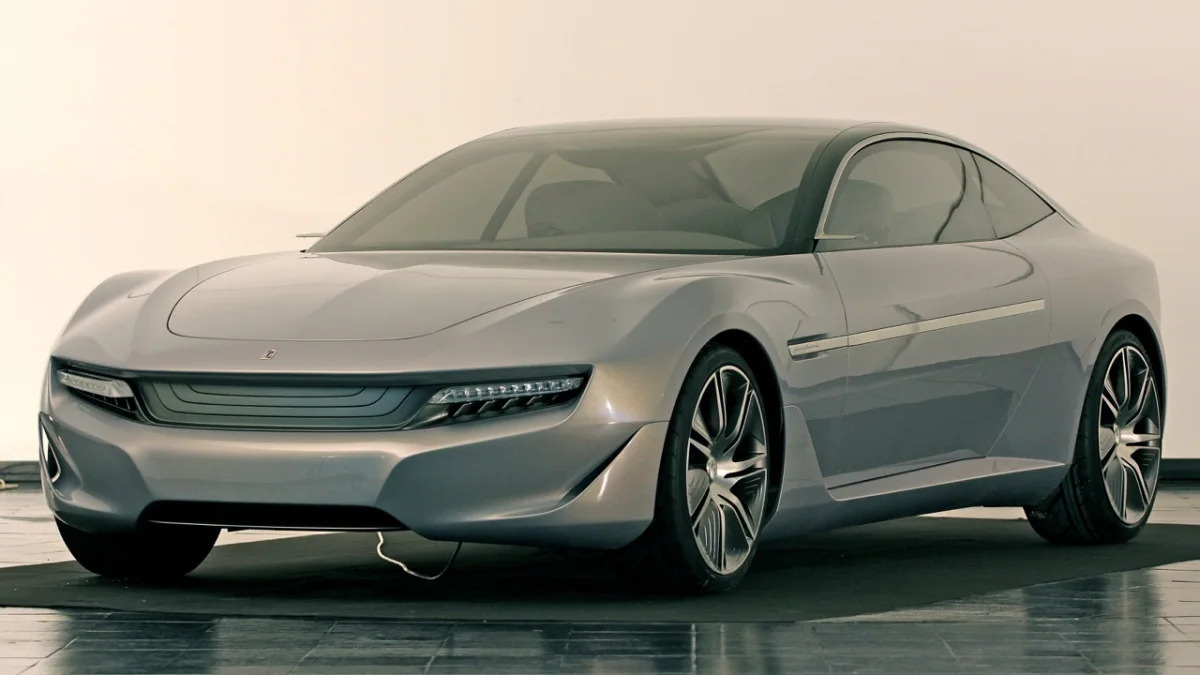









Sign in to post
Please sign in to leave a comment.
Continue